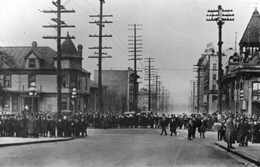This file contains Seattle historian and photographer Paul Dorpat's Now & Then photographs and reflections on Seattle's General Strike of 1919.
The Seattle General Strike
At 10 a.m. on February 6, 1919, 60,000 Seattle workers laid down their tools and returned to their homes, where they helped with the baby, washed windows, cut firewood, and stayed quiet. The Seattle General Strike of 1919, in support of shipyard workers who had struck two weeks earlier, lasted for five days (until February 11, 1919). The strike ended with no employer concessions.
The Union Record, Seattle's "Voice of Labor" and in 1919 the city's largest circulating newspaper, advised prudence in capital letters:
"SHOW YOUR LOYALTY TO THE CAUSE OF LABOR BY STAYING AT HOME; AVOID CONGREGATING IN CROWDS; AVOID DISCUSSION THAT MAY LEAD TO DISORDERLY DISPUTES; OBEY ORDERS."
It is this warning to "avoid congregating in crowds" that makes this historical picture a puzzle.
The photograph is from University of Washington's Historical Photograph Collection. A short caption on the back of the original print reads "February 7, 1919 [the second day of the strike], looking west on Pike Street from Ninth Avenue." This placing is almost right but not quite.
The view actually looks north down 7th Avenue, across its intersection with Union Street, toward the Waldorf Hotel, now Waldorf Towers, at Pike Street. If the caption gives the right date, then this gray winter scene is one of the very rare photographs of the General Strike. And these men have not stayed at home.
It is mostly men in this picture. They do not seem in the least disorderly. Dressed in the era's uniform - starched shirt, hat and tie (in 1919 you wore a tie to go fishing as easily as to go to church) -- these men look loosely lined up. Most are just standing around with their hands in their pockets, avoiding the rope strung across 7th Avenue.
They hardly display the dress or gestures of revolutionaries motivated by the "Hell inspired doctrines of Lenin and Trotsky," as Seattle Mayor "Holy Ole" Hanson charged on the third day of the strike. By the fourth day Hanson was no doubt daydreaming about the national tour he would soon make, lecturing on how he had beaten the Bolsheviks with 1,500 deputies, and tough talk.
The fifth day, February 11, 1919, was the last day of the Seattle General Strike. What followed was a run of press sensationalism, intensified class resentment, political opportunism (Hanson made a 1920 bid for the Republican presidential nomination), and a ruinous combination of post-World War I depression and inflation.
Strikers, at least, had proved that they could stop business-as-usual, and still supply local babies with milk, hospitals with clean linen, doctors with gasoline, and the hungry with stew. And they proved they could keep the peace, and stay quiet.

